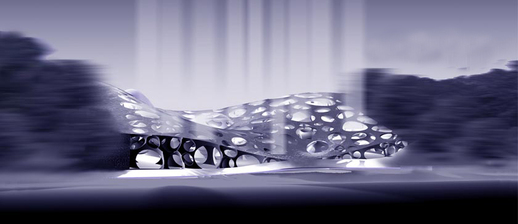Jeongok Prehistoric Museum
The competition for the Jeongok Prehistoric Museum originated from what was, really, a pretty modest discovery of a handful of ancient pots and artifacts in Jeongok, South Korea. Nonetheless, though meager in quantity, the presence of such archaic objects had considerable symbolic value to the community, which could now legitimately claim a millennia old heritage. Accordingly, the client wanted something commemorative, something that would attract tourists and visitors, something beyond the modest collection of recently unearthed pots. Hence, what we read to be, a call for a galvanizing piece of architecture that, prominently positioned on a hillside, will arrest the attention and interest of any passer-by.
The site, as mentioned, is located between two forested hills overlooking a broad valley. Imagining the violence already introduced to this idyllic landscape by the archaeological excavation, and anticipating the damaging effect of any architectural construction as well, we sought to minimize the impact of our design. We began by extracting the appropriate volume for the museum from the landscape, and then re-creating the same contours in the form of the building itself—a prosthetic hillside to replace that which we removed. For the interior spaces, we used a biomimetic process inspired by termite erosion to carve out the volumes appropriate to the program requirements. We merged as many spheroid volumes necessary for each program function, then we subtracted the resulting mass from the constructed hillside to create a series of beautifully vaulted interior spaces physically separated but visually connected by the intervening porous surfaces that remained after the simulated extraction.
The site, as mentioned, is located between two forested hills overlooking a broad valley. Imagining the violence already introduced to this idyllic landscape by the archaeological excavation, and anticipating the damaging effect of any architectural construction as well, we sought to minimize the impact of our design. We began by extracting the appropriate volume for the museum from the landscape, and then re-creating the same contours in the form of the building itself—a prosthetic hillside to replace that which we removed. For the interior spaces, we used a biomimetic process inspired by termite erosion to carve out the volumes appropriate to the program requirements. We merged as many spheroid volumes necessary for each program function, then we subtracted the resulting mass from the constructed hillside to create a series of beautifully vaulted interior spaces physically separated but visually connected by the intervening porous surfaces that remained after the simulated extraction.

